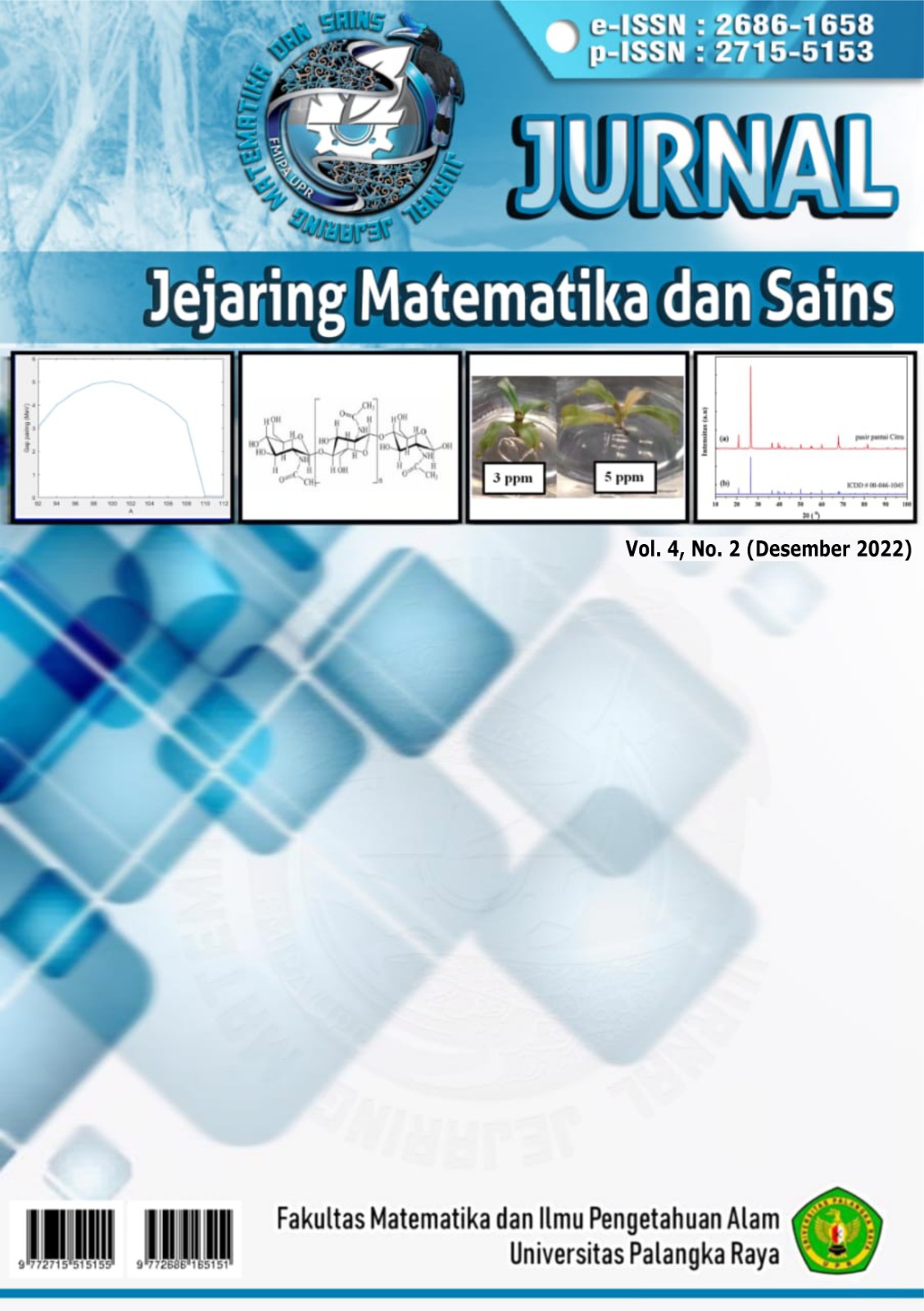Molecular Docking Senyawa α-mangostin sebagai Antiinflamasi secara In Silico
DOI:
https://doi.org/10.36873/jjms.2022.v4.i2.707Kata Kunci:
α-mangostin, ICE, inflamasi, in silico, molecular dockingAbstrak
Inflamasi atau peradangan adalah respon fisiologis tubuh terhadap infeksi dan cedera jaringan. Mediator inflamasi khususnya sitokin seperti tumor necrosis factor-alpha (TNF-α), interleukin-1 beta (IL-1β), dan interleukin-6 (IL-6) merupakan sitokin yang terlibat dalam inflamasi akut. Inflamasi dapat terjadi apabila mediator inflamasi tersebut saling berinteraksi. α-mangostin merupakan salah satu senyawa xanton yang terdapat dalam kulit buah manggis yang memiliki aktivitas sebagai antiinflamasi. Tujuan dari penelitian ini adalah untuk mengetahui mekanisme penghambatan terhadap protein ICE oleh senyawa α-mangostin secara in silico dengan molecular docking. Molecular docking secara in silico dilakukan dengan beberapa tahapan, seperti preparasi dan optimasi struktur 3D α-mangostin, preparasi protein target, validasi metode molecular docking, dan docking senyawa α-mangostin pada ICE yang mengacu pada parameter energi ikatan dan jenis ikatan yang terbentuk. Apabila nilai energi ikatan antara senyawa uji dengan protein target semakin rendah, maka ikatan yang terbentuk akan semakin kuat dan stabil. Hasil molecular docking α-mangostin terhadap protein ICE yaitu adanya afinitas antara α-mangostin terhadap protein ICE dengan energi ikatan sebesar -4,29 kkal/mol. Energi ikatan yang bernilai negatif menunjukkan bahwa α-mangostin memiliki aktivitas sebagai antiinflamasi dengan mekanisme penghambatan ICE.
Unduhan
Referensi
P.C. Calder, R. Albers, J. M. Antoine, S. Blum, R. Bourdet-Sicard, G. A. Ferns, and M. Løvik, “Inflammatory disease processes and interactions with nutrition,” British Journal of Nutrition, vol. 101, pp. 1-45, 2009.
A. N. Hasanah, F. Nazaruddin, E. Febriana, dan A. Zuhrotun, “Analisis kandungan minyak atisiri dan uji aktivitas antiinflamasi ekstrak rimpang kencur (Kampferin galangal L.),” Jurnal Matematika & Sains, vol. 16, no. 3, pp. 147-152, Desember 2011.
L. Ferrero-miliani, O. Nielsen, P. Anderson, and S. Girardin, “Cronic inflammation: importance to NOD2 and NALP3 in interleukin-1β generation,” Clinical & Experimental Immunology, vol. 147, pp. 227-235, 2007.
P. Conti, G. Ronconi, A. L. Caraffa, C. E. Galengga, R. Ross, L. Frydas, and S. K. Kritas, “Induction of pro-inflammatory cytokines (IL-1 and IL-6) and lung inflammation by Coronavirus-19 (COVI-19 or SARS-CoV-2): anti-inflammatory strategies,” J Biol Regul Homeost Agents,” vol. 34, pp. 327-331, 2020.
D. Blanco-Melo, B. E. Nilsson-Payant, W. C. Liu, S. Uhl, D. Hoagland, R. Moller, and T. T. Wang, et al., “Imbalanced host response to SARS-CoV-2 drives development of COVID-19,“ Cell, vol. 181, pp. 1036-1045, 2020.
S. Zhou, G. Wang, and W. Zhang, “Effect of TLR4/MyD88 signaling pathway on sepsis-associated acute respiratory distress syndrome in rats, via regulation of macrophage activation and inflammatory response,” Exp Ther Med, vol. 15, pp. 3376-8, 2018.
Y. Zhou, B. Fu, X. Zheng, D. Wang, C. Zhao, Y. Qi, H. Wei, et al., “Aberrant pathogenic GM-CSF+ T cells and inflammatory CD14+ CD16+ monocytes in severe pulmonary syndrome patients of a new coronavirus,” BioRxi, 2020.
H. Liu, K. Zhou, L. Liao, T. Zhang, M. Yang, and C. Sun, “Lipoxin A4 receptor agonist BML-111 induces autophagy in alveolar macrophages and protects from acute lung injury by activating MAPK signaling,” Respiratory Research, vol. 19, pp. 1-11, 2018.
F. Gutierrez-Orozco, C. Chitchumroonchokchai, G. B. Lesinski, S. Suksamrarn, and M. L. Failla, “α-mangostin: Anti-inflammatory activity and metabolism by human cell,” Journal of Agricultural and Food Chemistry, vol. 61, pp. 3891-3900, 2013.
R. I. Parmita, M. I. Ilmiawan, dan I. Armyanti, “Uji efek antiinflamasi kombinasi astaxanthin dan ekstrak kulit manggis (Garcinia mangostana Linn) pada tikus putih galur wistar,” Jurnal Cerebellum, vol. 3, no. 1, pp. 689-696, Februari 2017.
A. N. Jain and A. Nicholls, “Recommendations for evaluation of computational methods,” Journal of Computer-Aided Molecular Design, vol. 22, pp. 133-139, 2008.
B. Mukesh and K. Rakesh, “Molecular Docking: a Review,” International Journal of Research in Ayurveda and Pharmacy, vol. 2, pp. 1746-1751, 2011.
Hypercube, Hyperchem Release 7: Tools for Molecular Modelling, Canada: Hypercube Incorporation, 2002.
L. Franchi, T. Eigenbrod, R. Muñoz-Planillo, and G. Nuñez, “The inflammasome: a caspase-1-activation platform that regulates immune responses and disease pathogenesis,” Nature Immunology, vol. 10, pp. 241-247, 2009.
P. Prior and G.S. Salvesen, “The protein structures that shape caspase activity, specificity, activation and inhibition,” Biochemical Journal, vol. 384, pp. 2021-232, 2004.
R. Huey, G. M. Morris, and S. Forli, Using AutoDock 4 and AutoDock Vina with AutoDockTools: A Tutorial, California: Scripps Research Institute, 2012.
G. M. Morris, R. Huey, W. Lindstrom, M. F. Sanner, R. K. Belew, D. S. Goodsell, et al., “AutoDock4 and AutoDockTools4: Automated Docking with Selective Receptor Flexibility,” Journal of Computational Chemistry, vol. 30, pp. 2785-1791, 2009.
N. W. Diyah, Siswandono, S. Hardjono, dan B. T. Purwanto, “Pemodelan Molekul dan Hubungan Kuantitatif Struktur-Aktivitas Sitotoksik Turunan Benzoilurea sebagai Antitumor,” Berkala Ilmiah Kimia Farmasi, vol. 2, 2013.
S. Mohan, S. Syam, S. I. Abdelwahab, and N. Thangavel, “Anti-inflammatory molecular mechanism of action of α-Mangostin, the major xanthone from the pericarp of Garcinia mangostana; an in silico, in vitro and in vivo approach,” Food & Function, vol. 9, no. 7, pp. 3860-3871, Juli 2018.

Unduhan
Diterbitkan
Cara Mengutip
Terbitan
Bagian
Lisensi
Hak Cipta (c) 2023 Jurnal Jejaring Matematika dan Sains

Artikel ini berlisensiCreative Commons Attribution-NonCommercial-ShareAlike 4.0 International License.
















